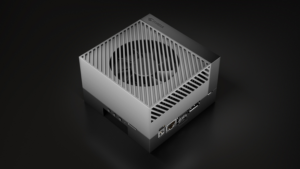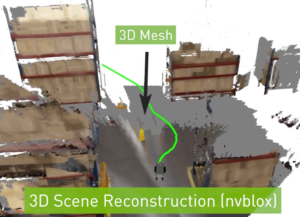

Nvidia Jetson Orin
Amid the flood of news coming out of Nvidia’s GPU Technology Conference (GTC) today were pair of announcements aimed at accelerating the development of AI on the edge and enabling autonomous mobile robots, or AMRs.
First, let’s cover Nvidia’s supercomputer for edge AI, dubbed Jetson. The company today launched Jetson AGX Orin, its most powerful GPU-powered device designed for AI inferencing at the edge and for powering AI in embedded devices.
Armed with an Ampere-class Nvidia GPU, up to 12 Arm Cortex CPU, and up to 32 GB of RAM, Jetson AGX Orin is capable of delivering 275 trillion operations per second (TOPS) on INT8 workloads, which is more than an 8x boost compared to the previous top-end device, the Jetson AGX Xavier, Nvidia said.
Jetson AGX Orin is pin and software compatible to the Xavier model, so the 6,000 or so customers that have rolled out products with the AI processor in them, including John Deere, Medtronic, and Cisco, can basically just plug the new device into the solutions they have been developing over the past three or four years, said Deepu Talla, Nvidia’s vice president of embedded and edge computing.
The developer kit for Jetson AGX Orin will be available this week at a starting price of $1,999, enabling users to get started with developing solutions for the new offering. Delivery of production-level Jetson AGX Orin devices will start in the fourth quarter, and the units will start at $399.
Recent developments at Nvidia will accelerate the creation of AI applications, Talla said.
“Until a year or two ago, very few companies could build these AI products, because creating an AI model has actually been very difficult,” he said. “We’ve heard it takes months if not a year-plus in some cases, and then it’s…a continuous iterative process. You’re not done ever with the AI model.”
However, Nvidia has been able to reduce that time considerably by doing three things, Talla said.
The first one is including pre-trained models for both computer vision and conversational AI. The second is the ability to generate synthetic data on its new Omniverse platform. Lastly, transfer learning gives Nvidia customers the ability to take those pre-trained models and customize them to a customer’s exact specifications by training with “both physical real data and synthetic data,” he said.
“We are seeing tremendous amount of adoption because just make it so easy to create AI bots,” Talla said.

Nvidia is developing simulation tools to help developers create AMRs that can navigage complex real-world environments (Image courtesy Nvidia)
Nvidia also announced the release of Isaac Nova Orin, is a reference platform for developing AMRs trained with the company’s AI tech.
The platform combines two of the new Jetson AGX Orin discussed above, giving it 550 TOPS of compute capacity, along with additional hardware, software, and simulation capabilities to enable developers to create AMRs that work in specific locations. Isaac Nova Orin also will be outfitted with a slew of sensors, including regular cameras, radar, lidar, and ultrasonic sensors to detect physical objects in the real world.
Nvidia will also ship new software and simulation capabilities to accelerate AMR deployments. A key element there is another offering called Isaac Sim on Omniverse, which will enable developers to leverage virtual 3D building blocks that simulate complex warehouse environments. The developer will then train and validate a virtual version of the AMR to navigate that environment.
The opportunity for AMRs is substantial across multiple industries, including warehousing, logistics, manufacturing, healthcare, retail, and hospitality. Nvidia says research from ABI Research forecasts the market for AMRs to grow from under $8 billion in 2021 to more than $46 billion by 2030.
“The old method of designing the AMR compute and sensor stack from the ground up is too costly in time and effort, says Nvidia Senior Product Marketing Manager Gerard Andrews in an Nvidia blog post today. “Tapping into an existing platform allows manufacturers to focus on building the right software stack for the right robot application.
Related Items:
Models Trained to Keep the Trains Running
Nvidia’s Enterprise AI Software Now GA
Nvidia Inference Engine Keeps BERT Latency Within a Millisecond
May 9, 2025
- BigID Introduces Executive Console to Streamline Privacy Reporting and Decision-Making
- Cerebras Partners with IBM to Accelerate Enterprise AI Adoption
- Franz Launches AllegroGraph 8.4 with Enhanced Natural Language Query for Agentic AI
- Peer Software Introduces New Features to PeerGFS for Multi-Protocol AI and Edge Workflows
May 8, 2025
- Amplitude Announces New Strategic Collaboration Agreement with AWS
- Domino Survey Shows Enterprises Prioritizing Governance Over GenAI Hype
- DataRobot Launches New Federal AI Application Suite to Unlock Efficiency and Impact
- Qlik Announces Close of Significant Investment Led by ADIA and Thoma Bravo
- OpenSearch 3.0 Enhances Vector Database Performance, Search Infrastructure and Scalability to Meet AI-driven Demand
May 7, 2025
- SAS Viya Expands AI Portfolio with Copilot, Intelligent Decisioning, and Synthetic Data Tools
- Grafana Labs Demonstrates Open Source Leadership at GrafanaCON 2025
- Neo4j Launches Industry’s 1st Graph Analytics Offering for Any Data Platform
- Cockroach Labs Brings Distributed SQL to IBM LinuxONE and Linux on IBM Z
- SAS Unveils AI Agents with Customizable Human-AI Interaction for Transparent Decisioning
- Coralogix Launches Continuous Profiling for Real-Time Application Visibility with Minimal Overhead
May 6, 2025
- Forrester Unveils Top 10 Emerging Technologies for 2025
- NetApp and Intel Partner to Redefine AI for Enterprises
- Algolia Introduces Smart Groups to Bring AI-Powered Curation and Automation to Content Teams and Merchandisers
- Traject Data Boosts Visibility into Google’s AI Overview with New Enhancements
- Qlik Accelerates Move to Cloud with New Analytics Migration Tool
- PayPal Feeds the DL Beast with Huge Vault of Fraud Data
- The Active Data Architecture Era Is Here, Dresner Says
- Slash Your Cloud Bill with Deloitte’s Three Stages of FinOps
- Thriving in the Second Wave of Big Data Modernization
- Monte Carlo Brings AI Agents Into the Data Observability Fold
- Inside the Chargeback System That Made Harvard’s Storage Sustainable
- AI Today and Tomorrow Series #4: Frontier Apps and Bizops
- Ambari Hadoop Cluster Manager is Back on the Elephant
- Google Cloud Fleshes Out its Databases at Next 2025, with an Eye to AI
- Google Cloud Preps for Agentic AI Era with ‘Ironwood’ TPU, New Models and Software
- More Features…
- Google Cloud Cranks Up the Analytics at Next 2025
- GigaOM Report Highlights Top Performers in Unstructured Data Management for 2025
- SnapLogic Connects the Dots Between Agents, APIs, and Work AI
- Databricks and KPMG Invest in LlamaIndex to Unlock Scalable Enterprise AI
- AI One Emerges from Stealth to “End the Data Lake Era”
- Supabase’s $200M Raise Signals Big Ambitions
- Dataminr Bets Big on Agentic AI for the Future of Real-Time Data Intelligence
- Fivetran Aims to Close Data Movement Loop with Census Acquisition
- Do You Own Your Data? Third-Party Doctrine Says No
- Sigma Secures $200M Round to Advance Its BI and Analytics Solutions
- More News In Brief…
- Gartner Predicts 40% of Generative AI Solutions Will Be Multimodal By 2027
- GitLab Announces the General Availability of GitLab Duo with Amazon Q
- BigDATAwire Unveils 2025 People to Watch
- Dataminr Raises $100M to Accelerate Global Push for Real-Time AI Intelligence
- SAS Unveils AI Agents with Customizable Human-AI Interaction for Transparent Decisioning
- Deloitte Survey Finds AI Use and Tech Investments Top Priorities for Private Companies in 2024
- Databricks Announces Data Intelligence Platform for Communications
- Dremio Named Top Vendor in Dresner 2025 Active Data Architecture Report
- Kroger and NVIDIA to Reinvent the Shopping Experience Through AI-Enabled Applications and Services
- Dataminr Unveils Agentic AI Roadmap to Advance Real-Time Decision-Making
- More This Just In…
Sponsored Partner Content
-
Mainframe data: A powerful source for AI insights
-
CData recognized in the 2024 Gartner ® Magic Quadrant™ Report
-
Introducing AIStor, the most powerful version of MinIO to date
-
Designing a Copilot for Data Transformation
-
Get your Data AI Ready – Celebrate One Year of Deep Dish Data Virtual Series!
-
Supercharge Your Data Lake with Spark 3.3




























